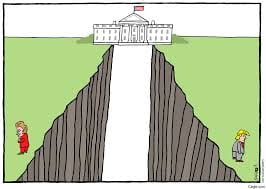BY ZAMIRAH HUSSAIN – STAFF WRITER
At the end of February, Hope Hicks announced her resignation from White House Communications Director after three years of working under various titles for current President Donald Trump. Hicks is a former model turned public relations consultant.
It was through her work as a consultant that she met Ivanka Trump. Subsequently, Hicks worked for the Trump Organization before being hired as press secretary and communications director for the President’s 2016 campaign. She is one of the President’s longest-serving aides and her departure is considered significantly unexpected.
Hicks’ resignation is one of the latest in a long line of unprecedented resignations and firings in the White House and federal government administration. But what is causing this consistent shift in positions? The issue can be narrowed down to the qualifications, burnout, and dismissal of staff as well as environmental conditions.
Public opinion has expressed enormous discontent with those appointed to governmental positions. For example, Callista Gingrich, the wife of former Speaker of the U.S. House of Representatives Newt Gingrich, was appointed as ambassador to the Vatican in July 2017 and confirmed by the Senate in October 2017. Some argue that she has zero qualifications to be ambassador from her limited career in politics and as a children’s book author.
Though somewhat common in government jobs, the high levels of burnout seen in the current White House’s resignations and firings is unprecedented. This burnout can be at least partly attributed to what is described as a consistently hostile workplace. The chaos of the White House has produced an unstable and difficult environment. Following Trump’s election and inauguration, strong popular resistance has fed into a feeling of instability within the White House. In addition to protests, the strong media attention, and a rapidly unifying Democratic party, external influence produces a high-pressure environment where resignations and firings are commonplace.
A top Environmental Protection Agency official, Elizabeth Southerland, resigned in protest of the big changes President Trump and his appointed Administrator Scott Pruitt have enacted. She worked for the EPA for 30 thirty years and published a scathing exit letter available online, criticizing the actions of the President and his appointees.
The impacts of these resignations and firings are widespread. What’s more, there are a significant amount of positions that have not been filled at all. The lack of any personnel in these openings has affected diplomacy, as well as domestic issues like the opioid epidemic and the economy.
There has not been an ambassador to Saudi Arabia since January 2017 and there are also no ambassadors for Yemen, Qatar, Jordan, and Egypt. For the United States government to not have an ambassador yet regularly interact with these countries does not bode well for foreign relations.
President Trump has not appointed a director for the Office of National Drug Control Policy. This department is responsible for leading the development, implementation, and assessment of U.S.
drug policy. The lack of a director leads critics to point out that the ongoing opioid epidemic continues unaddressed despite President Trump’s claim that it is a priority.
Economically, the chaos of the White House is obviously not beneficial. Any kind of instability is questionable but having substantial unfixed positions within the government is not advantageous when trying to ensure a stable economy. So far, there have been several instances of the Dow Jones Stock Index dropping in response to a resignation or firing.
Compared to other administrations, the Trump presidency is producing an uncommon amount of turn-over. It is the norm for presidents to change personnel at least two years into their presidency: former President Barack Obama had five communications directors over his entire eight years in office. Yet the fact that we are still in the early stages of Trump’s presidency makes the current phenomenon uniquely alarming.

